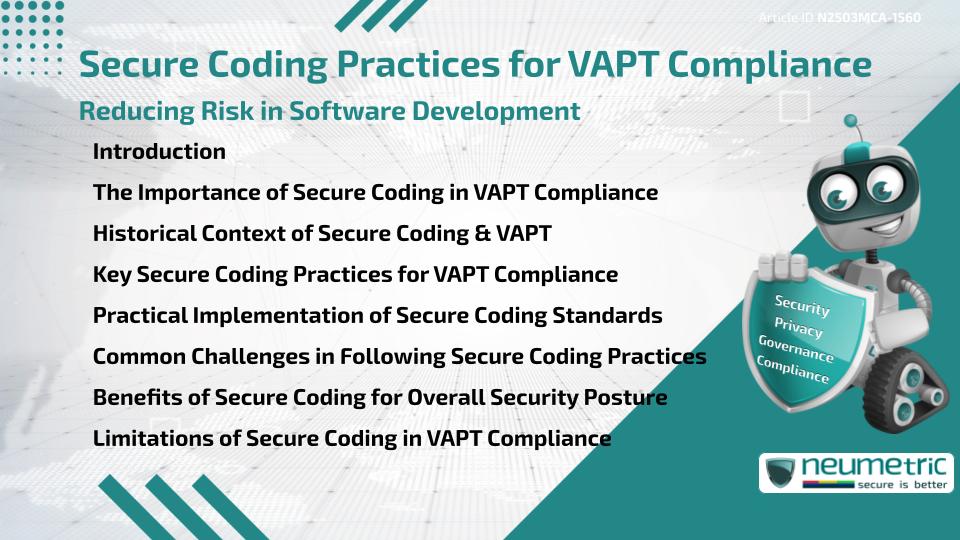Table of Contents
ToggleIntroduction
Secure Coding Practices for VAPT Compliance are no longer a choice but a necessity. As software becomes the heart of Business Operations, Vulnerabilities in code can lead to significant Risks. Vulnerability Assessment & Penetration Testing [VAPT] identifies these gaps, but prevention starts much earlier. Writing secure code ensures fewer Vulnerabilities, smoother VAPT audits & stronger overall security.
The Importance of Secure Coding in VAPT Compliance
Secure Coding Practices for VAPT Compliance create a protective barrier around software applications. Instead of relying solely on testing after development, integrating security during coding minimizes the surface area attackers can exploit. It is like building a house with reinforced walls rather than patching cracks later.
VAPT efforts then focus on finer points rather than major gaps, ensuring that Compliance is not reactive but proactive.
Historical Context of Secure Coding & VAPT
In the early 2000s, most companies treated security as an afterthought. Software would be built first & Security Assessments like VAPT would come just before release. This approach led to last-minute patches, delays & costly breaches.
Over time, especially after major incidents like the SQL Slammer worm, Organisations realized that secure coding must happen early. Secure Coding Practices for VAPT Compliance evolved as businesses understood that prevention is far cheaper & more reliable than correction.
Key Secure Coding Practices for VAPT Compliance
Several Core Principles support Secure Coding Practices for VAPT Compliance:
- Input Validation: Always check & sanitize User inputs to prevent injections & data breaches.
- Authentication & Authorization: Implement strong methods to control access & protect Sensitive Data.
- Error Handling: Manage errors securely without exposing system details to users or attackers.
- Data Encryption: Secure data both at rest & in transit to block unauthorized access.
- Code Reviews & Testing: Conduct regular peer reviews & static code analysis to find issues early.
Each of these practices forms a layer of defense, strengthening software before it faces external testing through VAPT.
Practical Implementation of Secure Coding Standards
Secure Coding Practices for VAPT Compliance can be practically embedded through simple measures:
- Training Developers: organise regular workshops & tutorials to keep developers updated.
- Secure Coding Guidelines: Create easy-to-follow coding Policies based on standards like OWASP Top Ten.
- Automated Tools: Use static & dynamic analysis tools to scan code during development.
- Secure Development Lifecycle [SDLC]: Integrate security checks at every stage from design to deployment.
Think of it like regular health check-ups; small, regular efforts prevent big problems later.
Common Challenges in Following Secure Coding Practices
While Secure Coding Practices for VAPT Compliance are critical, several challenges persist:
- Time Pressure: Fast project deadlines often tempt teams to bypass security steps.
- Knowledge Gaps: Not all developers are trained in secure coding techniques.
- Complex Legacy Systems: Older systems may have poor security foundations, making new coding practices hard to apply.
These challenges show why leadership support & consistent training are essential to make secure coding a habit rather than an afterthought.
Benefits of Secure Coding for Overall Security Posture
By adopting Secure Coding Practices for VAPT Compliance, Organisations enjoy multiple benefits:
- Reduced Risk of Breaches: Secure code lowers the chances of exploitation.
- Faster VAPT Clearance: Fewer Vulnerabilities mean quicker & cheaper VAPT reports.
- Stronger Brand Trust: Customers prefer companies that prioritise security.
- Cost Savings: Fixing issues in production is far costlier than preventing them during development.
In essence, secure coding transforms security from a reaction to a responsibility.
Limitations of Secure Coding in VAPT Compliance
Despite its importance, Secure Coding Practices for VAPT Compliance are not a complete solution:
- Not All Vulnerabilities Are Caught: Some issues only appear during real-world attacks.
- Requires Continuous Effort: Secure coding is not a one-time setup but a continual commitment.
- Relies on Human Skill: Even the best guidelines fail if developers do not apply them properly.
Thus, secure coding must work alongside regular VAPT efforts, Incident Response plans & Security Monitoring.
Conclusion
Secure Coding Practices for VAPT Compliance act as the first line of defense in software security. By embedding security into the very foundation of code, businesses not only comply with standards but also protect their reputation & resources. Although challenges exist, the benefits far outweigh the effort required. When secure coding & VAPT work together, Organisations can build resilient systems ready to face evolving Threats.
Takeaways
- Secure Coding Practices for VAPT Compliance should be part of everyday development, not an afterthought.
- Historical lessons show that proactive security saves time & money.
- Practical steps like training, guidelines & automated tools ease implementation.
- Challenges can be overcome with strong leadership support.
- Secure coding boosts overall business resilience beyond just Compliance.
FAQ
What are Secure Coding Practices for VAPT Compliance?
Secure Coding Practices for VAPT Compliance are development methods aimed at minimizing Vulnerabilities to ensure software passes Security Assessments smoothly.
Why is secure coding important for VAPT Compliance?
Secure coding is important because it reduces Security Gaps before testing, helping businesses pass VAPT assessments with fewer fixes needed afterward.
How does secure coding differ from VAPT?
Secure coding focuses on prevention during development, while VAPT identifies Vulnerabilities after a product is built & often close to release.
What are the main principles of secure coding for VAPT Compliance?
The main principles include input validation, strong authentication, proper error handling, Data Encryption & thorough code reviews.
Can automated tools ensure secure coding for VAPT Compliance?
Automated tools help a lot by detecting common issues early, but human oversight is still needed for thorough Secure Coding Practices for VAPT Compliance.
What challenges might developers face in following Secure Coding Practices?
Common challenges include tight deadlines, lack of security training & dealing with complex or outdated legacy systems.
Is secure coding enough to pass a VAPT assessment?
Secure coding significantly improves the chances but is not enough alone; regular testing & Continuous Monitoring are still necessary.
How often should developers be trained in secure coding?
Ideally, developers should receive secure coding training at least once a year, with updates as new Threats & coding standards emerge.
Need help?
Neumetric provides organisations the necessary help to achieve their Cybersecurity, Compliance, Governance, Privacy, Certifications & Pentesting goals.
Organisations & Businesses, specifically those which provide SaaS & AI Solutions, usually need a Cybersecurity Partner for meeting & maintaining the ongoing Security & Privacy needs & requirements of their Clients & Customers.
SOC 2, ISO 27001, ISO 42001, NIST, HIPAA, HECVAT, EU GDPR are some of the Frameworks that are served by Fusion – a centralised, automated, AI-enabled SaaS Solution created & managed by Neumetric.
Reach out to us!


